

Damion Smy
Boxy new KGM Musso unveiled to take on HiLux and Ranger ahead of Australian launch
10 Hours Ago
A $65,000 Kia? Scoff all you want, but the new Sorento GT-Line flagship represents a convincing move upmarket in many respects. It's not perfect, though.
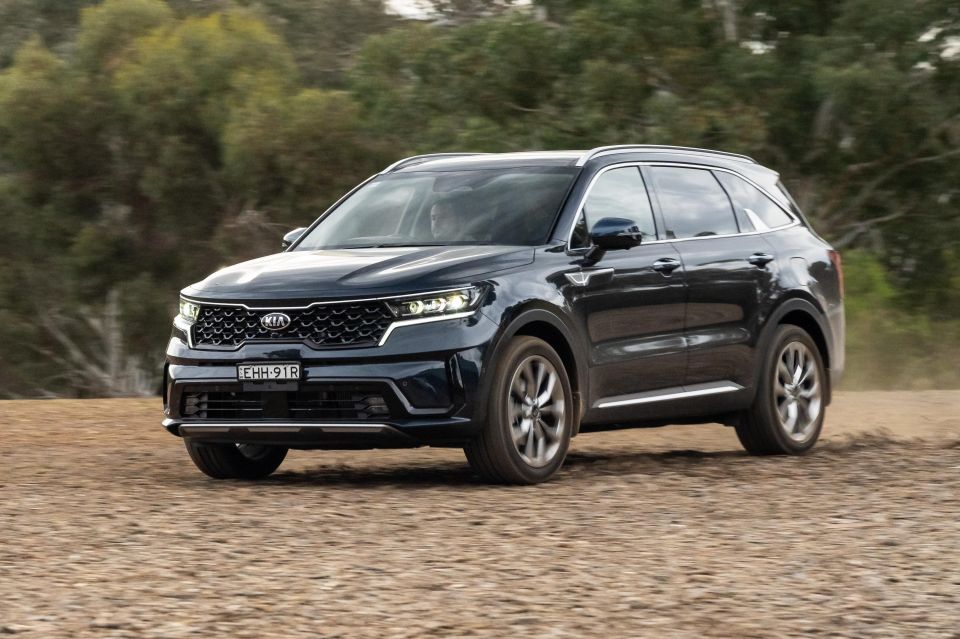
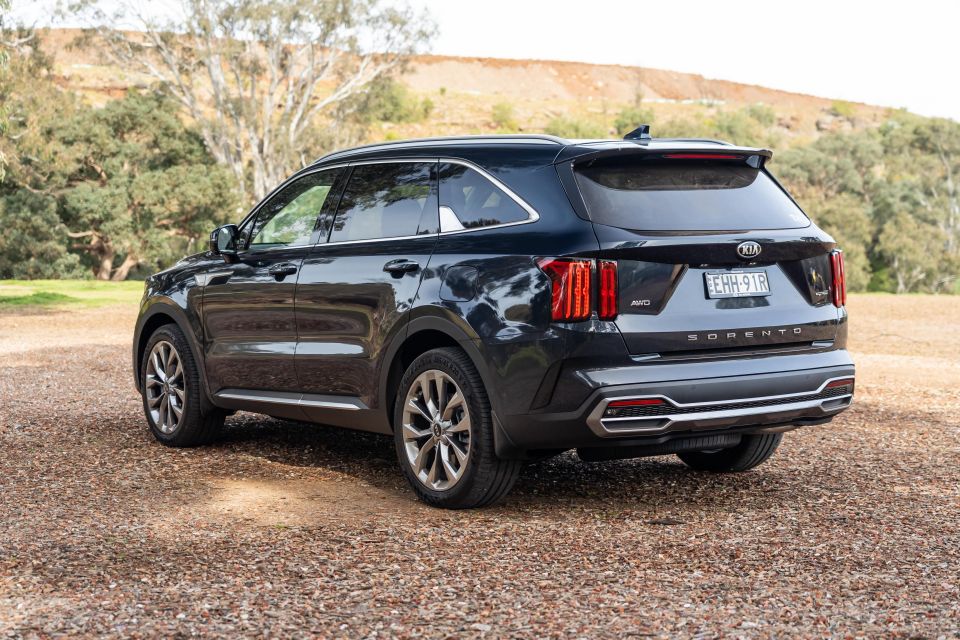

Marketplace Editor
New from
$59,490
excl. on-roads

Marketplace Editor
New from
$59,490
excl. on-roads


Marketplace Editor
New from
$59,490
excl. on-roads

Marketplace Editor
New from
$59,490
excl. on-roads
Quickly see how this car stacks up against its competition. Select any benchmark to see more details.
Where expert car reviews meet expert car buying – CarExpert gives you trusted advice, personalised service and real savings on your next new car.
The all-new Kia Sorento arrives with some big aspirations. The main one? Being considered a genuine alternative to established premium products from Europe.
It’s no secret Kia and its Hyundai parent have made huge inroads in recent years when it comes to desirability and overall quality, and the fourth-generation Sorento is aiming to push even further upmarket.
From next year the Sorento will offer no less than four powertrain choices in Australia, including a series hybrid and a plug-in hybrid – the first electrified models to ever be offered by Kia in Australia.
In the meantime, however, the headline act is the flagship 2021 KiaSorento GT-Line AWD we have here, with its newly refined ‘Smartstream’ 2.2-litre diesel and never-ending list of upmarket features.
Does the Sorento deserve to be cross-shopped against premium rivals as well as top-end mainstream competition?

The Sorento is currently offered in four trim levels (S, Sport, Sport+ and GT-Line) and with two powertrain options – a 3.5-litre V6 with front-wheel drive and the 2.2-litre turbo-diesel with all-wheel drive sampled here.
Officially, the top-spec Sorento GT-Line AWD starts at $63,070 before on-road costs, about $3000 more than before. In typical Kia fashion though, the Sorento launched with drive-away pricing, with the flagship diesel all-wheel drive model we have on test advertised from $64,990 on the road.
The only option available is premium paint, commanding a $695 premium. Our tester’s deep Gravity Blue is one of six premium finishes.
Further down the line-up, prices start at $45,850 before on-road costs for the V6-powered S 2WD (or $46,990 drive-away), climbing to $48,470 before on-roads ($49,990 drive-away) for the Sport V6, $52,850 before on-roads ($54,390 drive-away) for the Sport+ petrol, and $60,070 before on-roads ($61,990 drive-away) for the V6 petrol GT-Line.
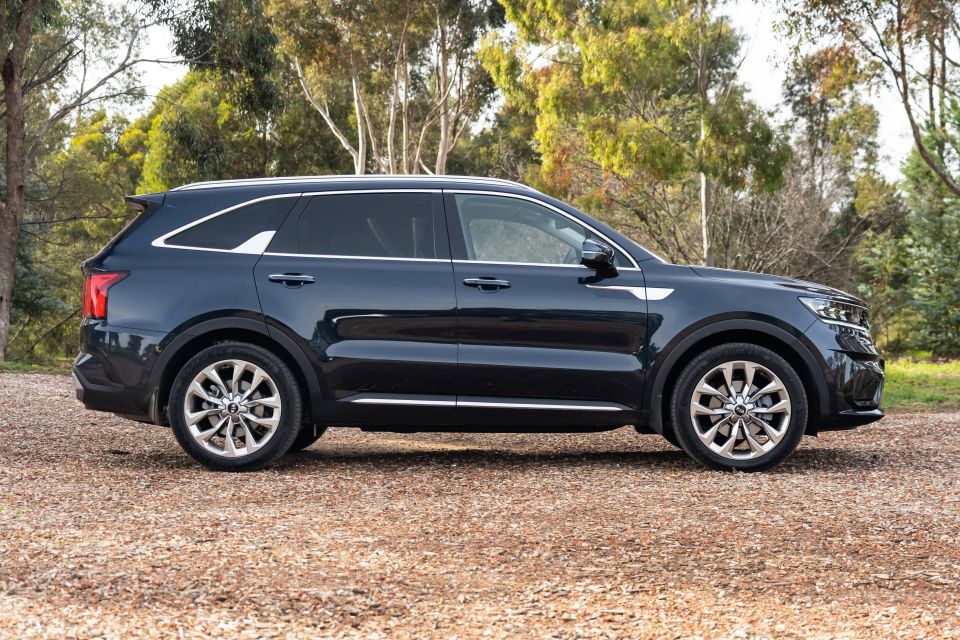
Diesel models add $3000 to the equivalent petrol, and come exclusively with all-wheel drive. Unlike in left-hand drive markets, the V6 petrol engine isn’t available with all-paw traction locally.
Compared to rivals like the Mazda CX-9 and Toyota Kluger, the Sorento is in the ballpark of top-end variants despite being a little smaller. A CX-9 Azami AWD will currently set you back $69,303 plus on-road costs, while the soon-to-be-replaced Kluger Highlander AWD can be had for $68,574 before on-roads.
At the premium end of the large SUV market, meanwhile, the entry-level Volvo XC90 D5 Momentum kicks off at $89,990 before on-road costs, while the five-seat only Volkswagen Touareg 190TDI starts at $80,790 list. The Volkswagen is on track to get a cleaner (but less powerful) V6 diesel in the coming months which will bump the entry price to $81,490 before on-roads.
It’s worth noting Kia benchmarked the Sorento against the Touareg and XC90 during development, no doubt in an effort to bridge the gap between mainstream and premium large SUVs.
Given the decent gap in price between the Sorento and its premium large SUV equivalents, you could realistically cross-shop the Kia with entry-level mid-sized luxury SUVs such as the Audi Q5 40 TDI ($66,900) and Land Rover Discovery Sport R-Dynamic S D165 ($68,000), both of which fitted with similarly-powerful four-cylinder diesels. The Land Rover also offers the option of seven seats.
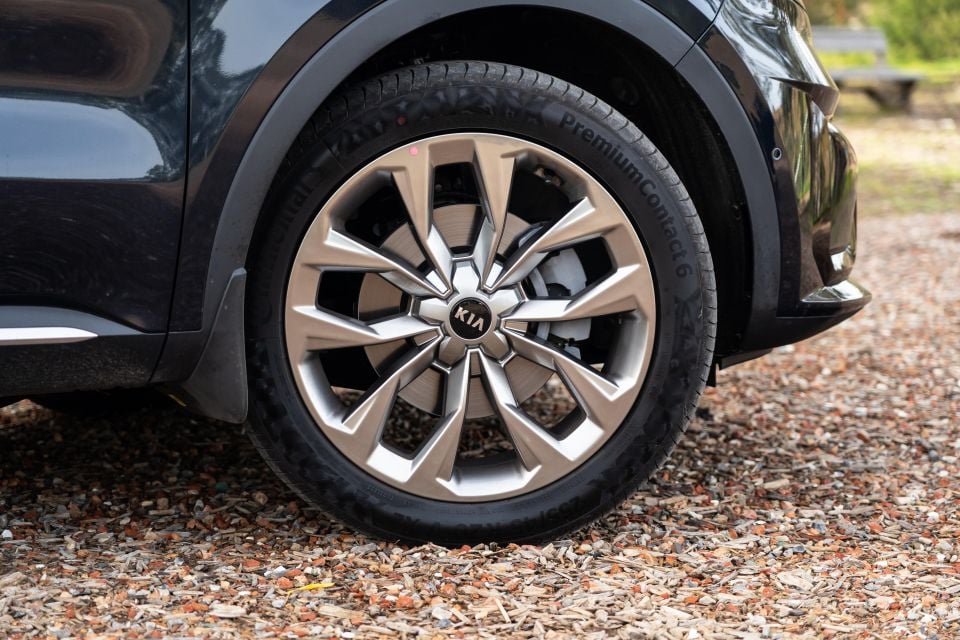
Buy your new car without the stress. It's fast, simple and completely free.

Great service from Travis and team, second time I have used this business would not hesitate to recommend them to anyone
Craig C.
Purchased a Ford Ranger in Sunshine Coast, QLD
CarExpert helped Craig save thousands on his Ford Ranger, now let us save you on your next new car.
Find a dealLong story short – a lot.
The GT-Line gets absolutely everything Kia can throw at it. Specification highlights include a 12.3-inch digital instrument display, an 8.0-inch colour head-up display, quilted nappa leather-appointed upholstery, 20-inch alloy wheels in dark chrome, a 12-speaker Bose audio system, 360-degree cameras, heated and ventilated front seats with heated outboard rear seats, a powered panoramic glass sunroof, and a wireless fast-charging pad for your compatible smartphone.
But wait, there’s more. The Sorento GT-Line features a full gamut of driver assistance technologies, exclusively getting the Blind Spot View Monitor system – which projects a live side camera feed into the instrument cluster when you indicate – as well as Remote Smart Parking Assist with Parking Collision Avoidance Assist, which allows you to pilot the Sorento in or out of a tight parking space from outside the vehicle using the key fob.
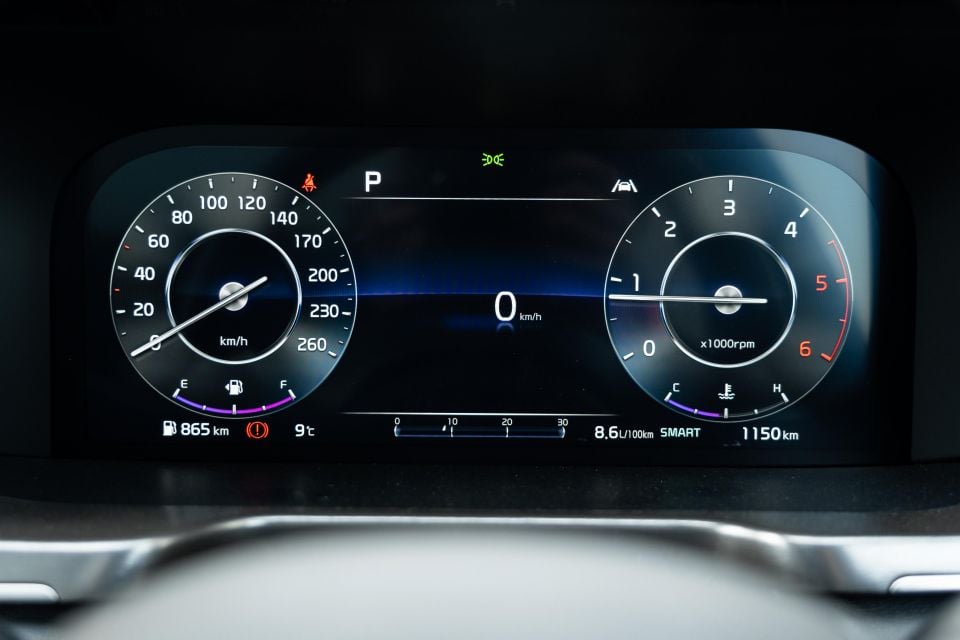
Plenty of kit is carried over from lower trim levels. Highlights include keyless entry with push-button start, remote engine start (via key fob), an electric tailgate, LED head- and tail lights, a heated steering wheel, dual-zone climate control with vents across all three rows, a 10.25-inch touchscreen with navigation, Apple CarPlay and Android Auto (both wired), tyre pressure monitoring, a 14-way power adjustable driver’s seat with memory and 10-way powered front passenger seat, rear privacy glass, as well as eight USB charge ports.
You certainly aren’t wanting for much, but there are a handful of items that you’d think would be standard or at least available, given the GT-Line’s price point and premium pitch.
There’s no climate control in the second and third rows, just vents for second-row occupants and a manual fan control in the third row. The Sorento’s high-resolution 10.25-inch central touchscreen also forgoes the wireless Apple CarPlay and Android Auto functionality of lesser Kia models like the Picanto and Rio hatches.
CarExpert founder, Anthony Crawford, also noted in his Australian launch review the Sorento lacks any form of adaptive damping or air suspension, which is fast-becoming a must-have in the upper-mainstream and premium segments.
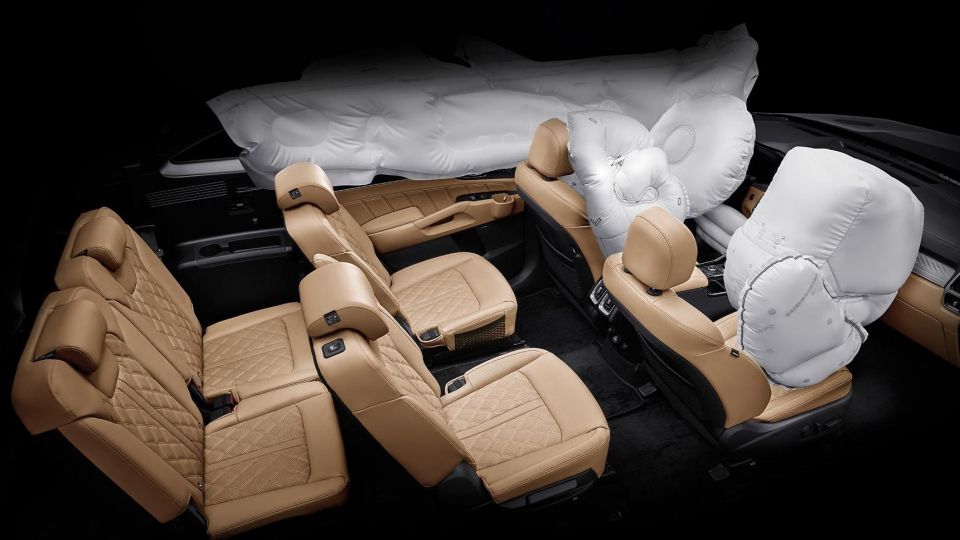
The new-generation Sorento is yet to be officially tested by independent crash-testing firm, ANCAP. It’s yet to be tested by Euro NCAP, either.
We’d be surprised if it fell short of five stars, and the new Sorento is packed with safety features to protect occupants in a collision, and even prevent crashes happening in the first place – especially in the flagship GT-Line trim we have on test.
Active safety features include autonomous emergency braking with pedestrian, cyclist and junction (cross-traffic) detection, lane-keeping assist with lane change assist, blind-spot monitoring, rear cross-traffic alert, high-beam assist, and driver attention monitoring, as well as adaptive cruise control with Lane Follow Assist for semi-autonomous highway driving.
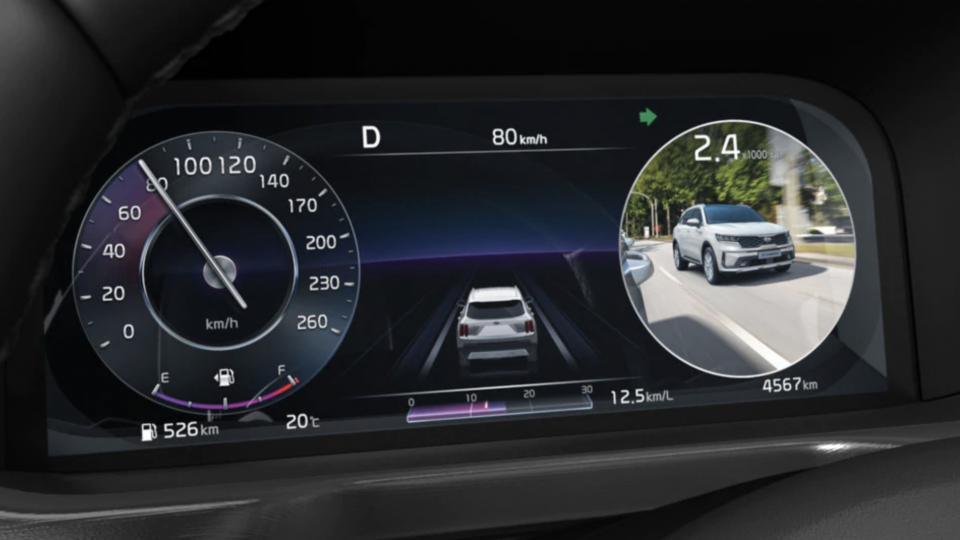
Beyond the suite of driver assistance technologies, the Sorento has dual front, front side, front centre, and side curtain (1st and 2nd rows) airbags, and impact-sensing automatic door unlocking.
Being a three-row family SUV, the lack of curtain airbag coverage for the third row of seats could be a key consideration for buyers planning to use it regularly. It’s also worth calling out the Sorento’s key rivals – the Mazda CX-9 and Toyota Kluger – are both fitted with airbags covering all three rows.
The GT-Line uniquely gets some whiz-bang gadgetry like the aforementioned Blind Spot View Monitor and Remote Smart Park Assist systems, 360-degree cameras, an 8.0-inch head-up display, and LED projector headlights – lower grades get reflector-type units.

It’s been well documented that Kia is aiming high with the Sorento, and the cabin ticks just about all the boxes necessary for a premium product.
The big displays are crisp and clear, the GT-Line’s lovely quilted nappa leather upholstery is a nice touch, there’s soft-touch materials lining the upper and middle tiers of the dashboard and doors, and all the touch points feel good in the hand and of a high quality.
Kia has certainly stepped it up from the previous-generation Sorento, and in general it presents really nicely compared to competing models in the segment.
That’s not to say it’s perfect, though. Like the Volkswagen Touareg I reviewed a couple months back, it seems the focus on features and tech has come at the price of cabin tactility in some areas.
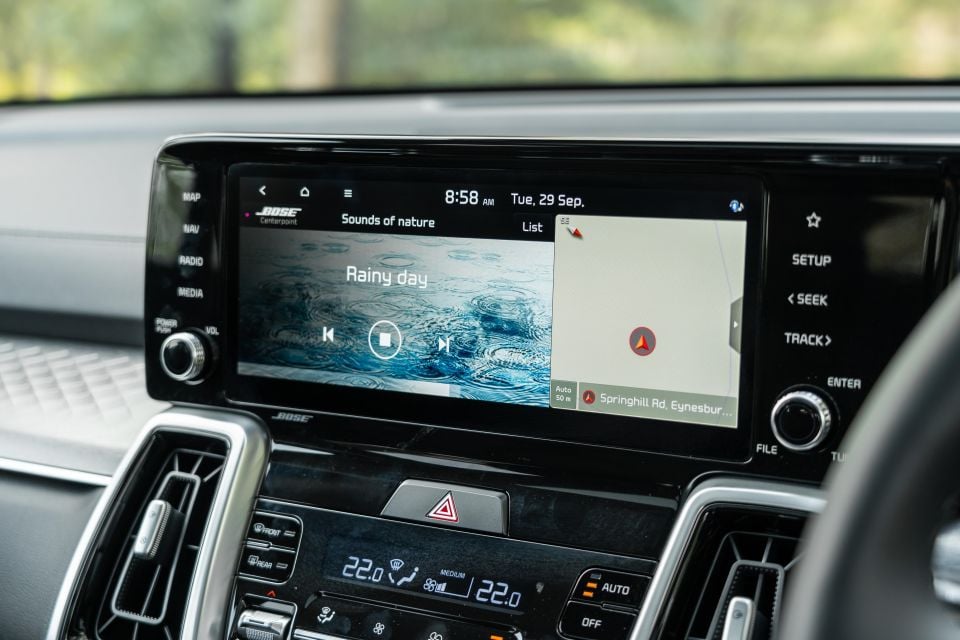

Call me over-critical, but the silver trim on the dash and doors that’s meant to look like brushed metal is a really cheap-feeling and looking plastic that just shouldn’t be here. The silver trim used for the air vent surrounds would have been much nicer.
I took similar issue with the hard, scratchy plastic lining the centre tunnel and parts of the doors. As a ‘challenger’ brand aiming for the premium marques, it’s not good enough to merely get near or match the perceived quality of rivals, you need to do better.
This view is strengthened by the fact Hyundai is promising an almost entirely soft-touch interior with the new Santa Fe – which the Sorento is essentially identical with in terms of mechanicals and tech.
I’d personally also like to see the additional tan and grey colourways available in South Korea offered locally, to give customers a little more choice and ability to personalise their vehicles. It’s pretty standard in the luxury segments to offer multiple interior choices, if that’s what the Sorento is aiming for.
Kia Australia said the current set of exterior and interior colour options “are adequate for our market’s tastes”, but left the door open to more choice over the Sorento’s current lifecycle.
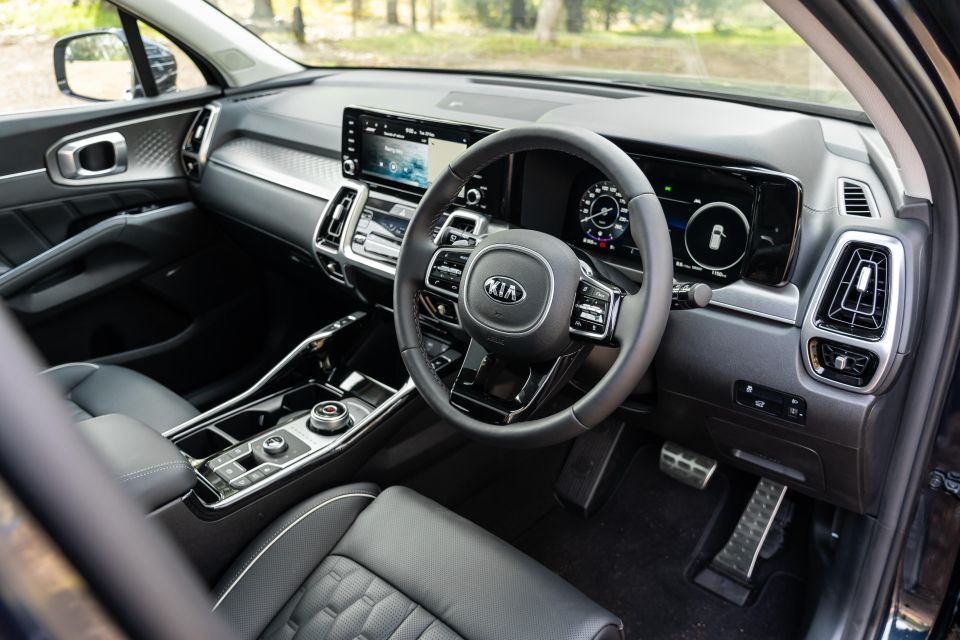
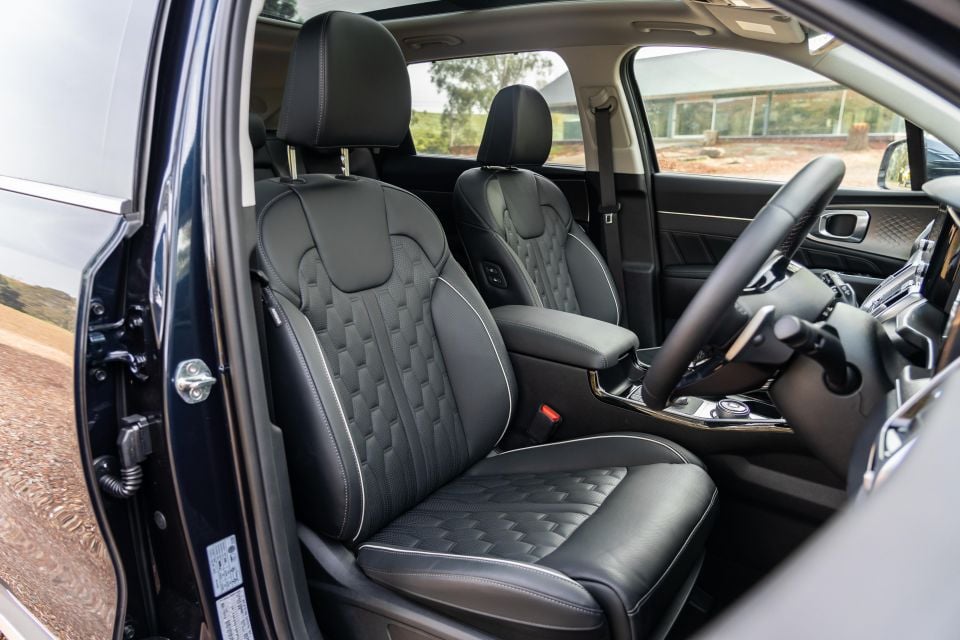

Minor quality complaints aside, the Sorento feels roomy and offers good amounts of storage, from the big phone cubby under the centre stack to the large door bins and huge storage nook under the centre armrest.
Drivers will appreciate the layout of all the controls and switchgear, which all seems to be within arm’s reach. There’s good adjustment in the (manual) steering wheel and (powered) driver’s seat to find that ideal perch – the memory settings help if you’re constantly swapping with a significant other, too.
The infotainment system does the job just fine, and the digital driver’s display is a nice upmarket touch. However, there’s oddly no wireless Apple CarPlay or Android Auto despite cheaper Kia models offering it as standard, and there isn’t a dedicated map view for the instrument cluster like you might find in similar systems from other brands.
If you’re into pumping the beats, the Sorento GT-Line’s 12-speaker Bose system offers great sound quality across all volume levels, with clear audio and nice deep bass.
Video quality from the surround camera system is great, though, and the Blind Spot View Monitor is a much better implementation of side camera assistance than Honda’s LaneWatch system. It also doesn’t cancel the conventional blind-spot monitoring system and the cameras work on both sides of the vehicle, not just the passenger side.
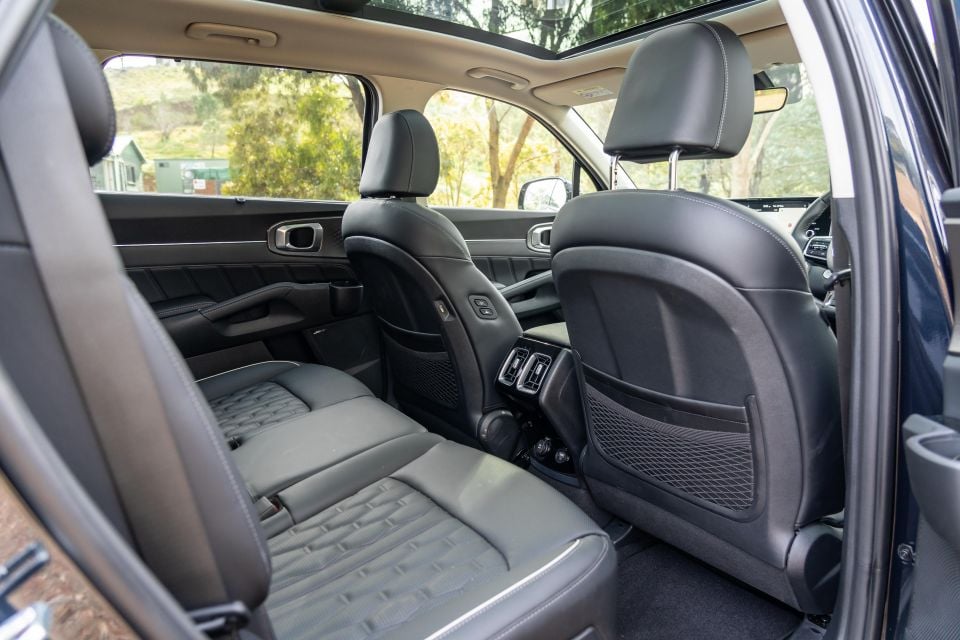
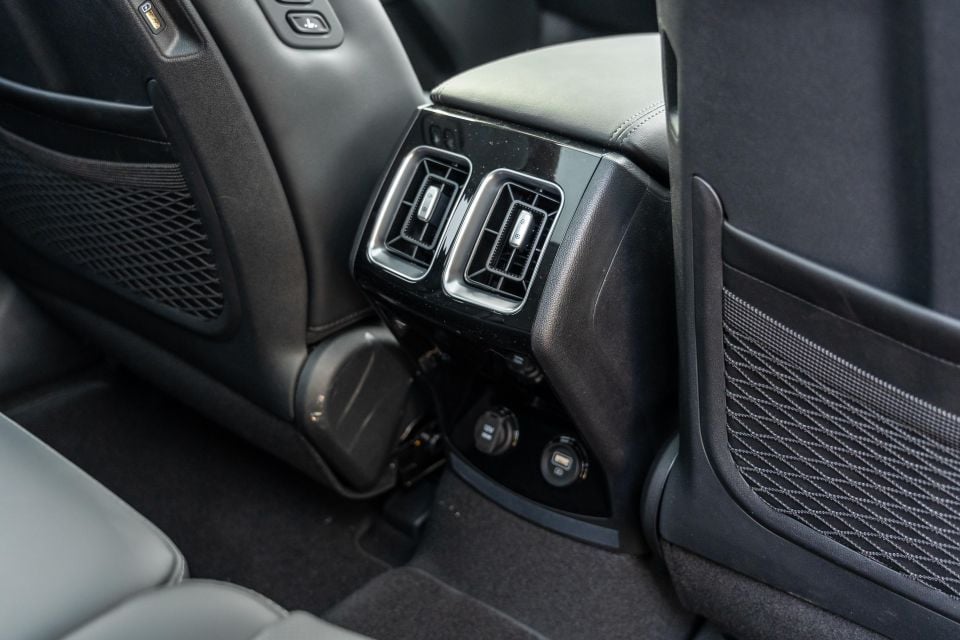
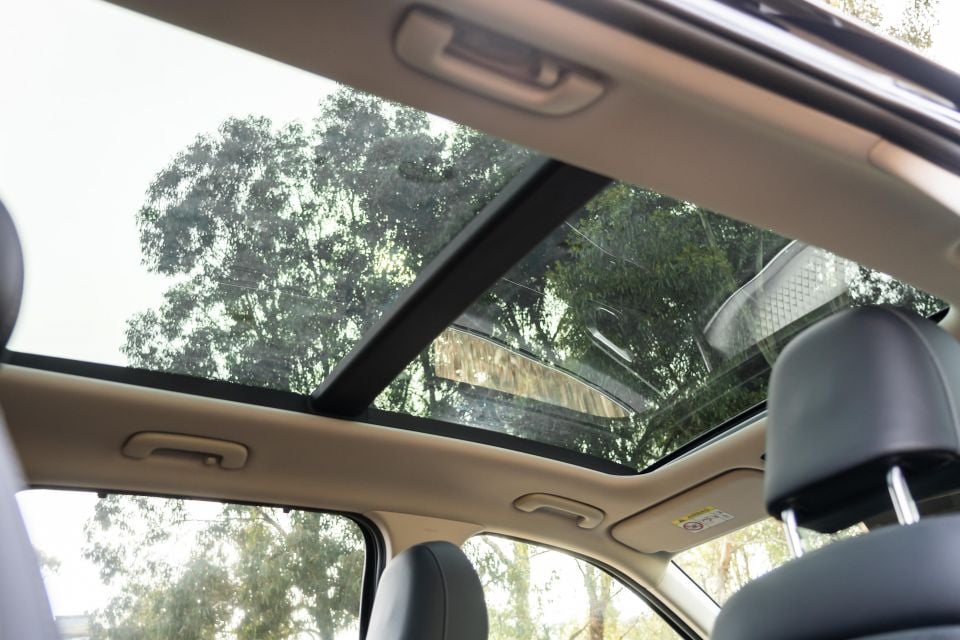
Moving further back, second-row occupants get a load of head and legroom, even with this model’s huge panoramic glass sunroof. Even behind my own driving position, I had heaps of leg- and toe-room, meaning lanky teenagers will be just fine behind taller parents.
The second row slides fore and aft to liberate more space for third-row passengers or luggage where appropriate, and even when slid forward to allow for someone my size to cram into the back, there was plenty of room. Three adults could realistically fit abreast for a decent stint, too.
Rear air vents are always welcome but the lack of separate temperature and fan controls for the second row seems like a bit of a miss, especially given the Sorento’s more premium aspirations and flagship status within the brand’s portfolio. Overseas the Sorento can be had in a chauffeur-style six-seat layout with second-row captain’s chairs, so the lack of a third zone for the climate control is a bit odd.
Decent door pockets and map nets behind the front seats mean there’s plenty of storage, and fast-charging USB ports mounted to the front seat backs and behind the centre tunnel mean all three passengers in the back can charge their phones and iPads on the move.
A rear fold-down centre armrest with cupholders completes the second-row amenities list.
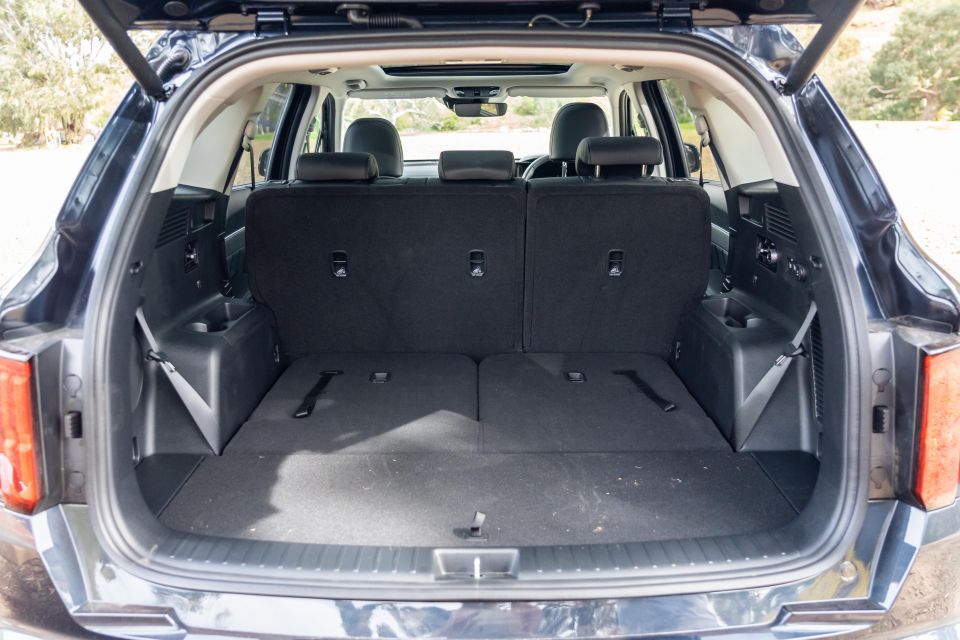
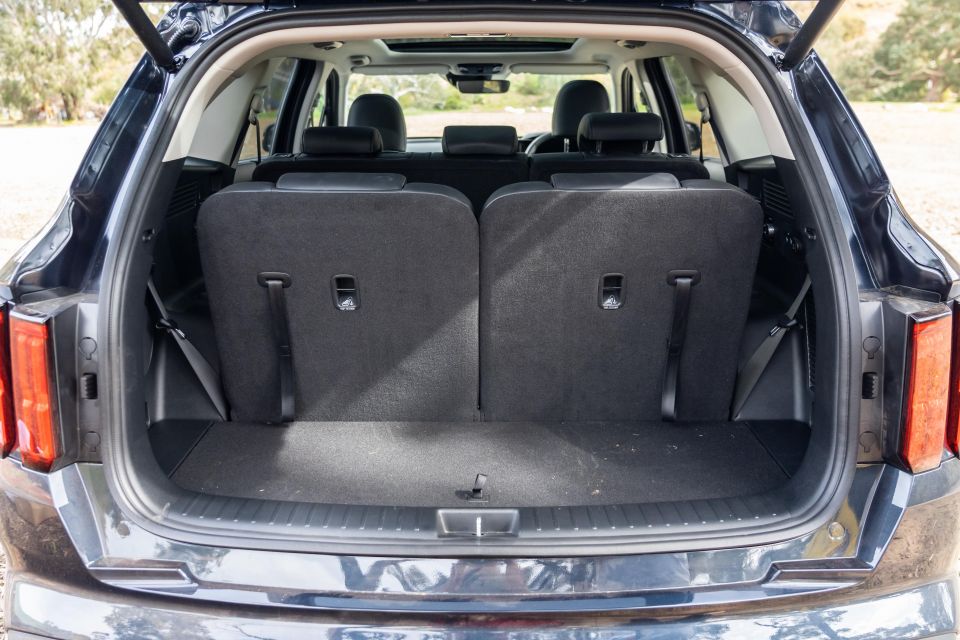
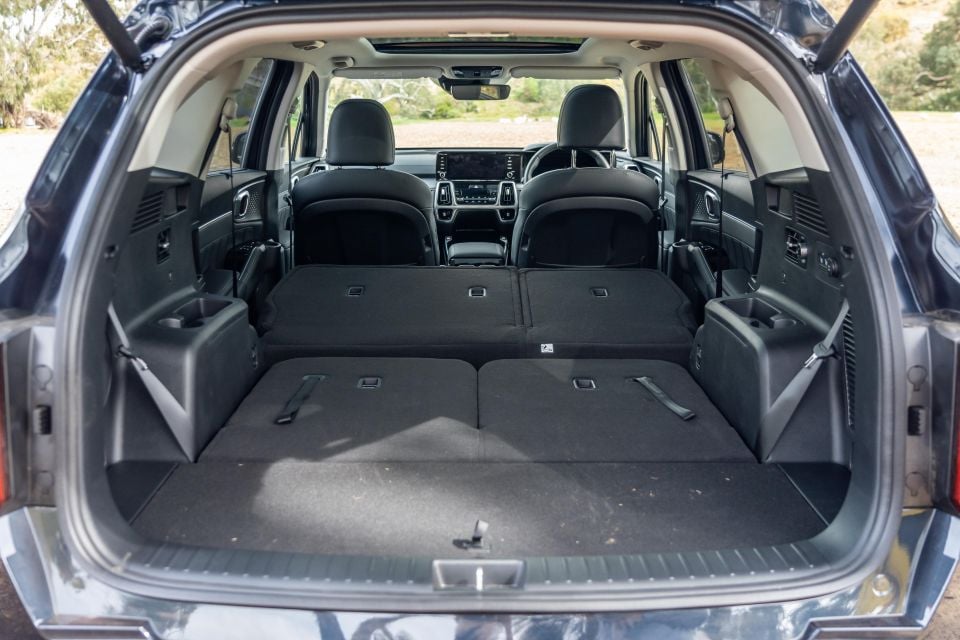
The third-row is fine without being outstanding. As is the case with most seven-seat SUVs, even in the larger segments, the sixth and seventh pews are best left to kids and early teens, as older, taller passengers won’t find it as accommodating.
Access is made slightly easier thanks to a new one-touch system that automatically folds and slides the seat forward, but the opening into the rearmost row isn’t the largest, and requires a certain level of flexibility if you’re of average height and build.
Headroom is tight for anyone six-foot and up, and the flat seat base means your knees are up quite high and putting most of your weight through a small patch – not great for long periods. Separate fan controls for the third row is good, as are the USB charge points and ample storage for a small bottle and phone.
In terms of luggage space, the Sorento offers 187L with the third row in place, 616L in its five-seat layout and 2011L with the second and third rows folded flat.
All versions feature a full-size alloy spare under the boot floor, and there’s even space to spare to stow the rear cargo blind. That may seem like a small thing, but you’d be surprised how many vehicles in the class haven’t thought these things out so well.
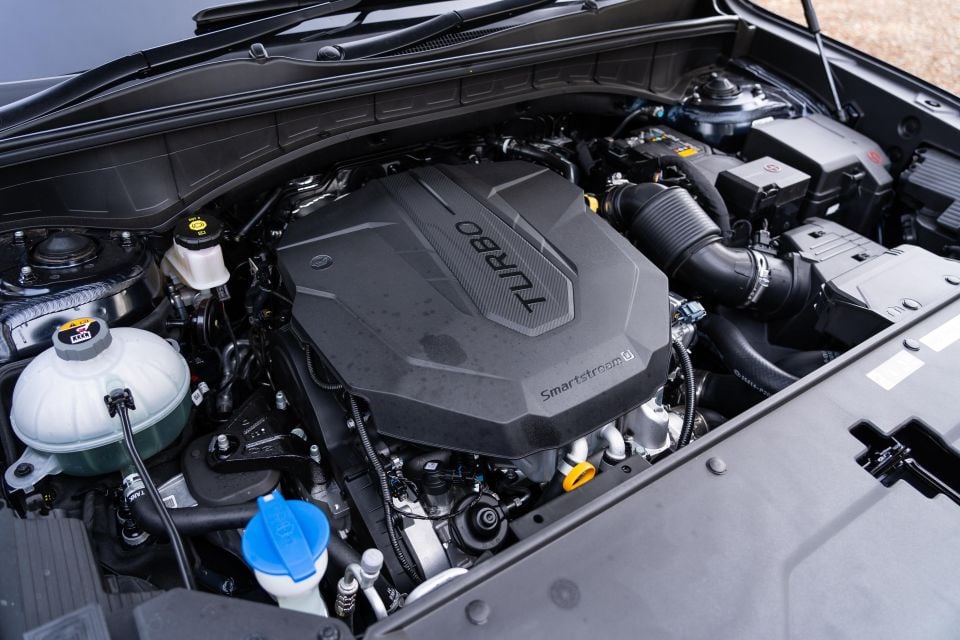
The new Sorento launches with more of the same under the bonnet, though both ‘carryover’ powertrains have been revised to wear Kia’s efficiency-focused ‘Smartstream’ branding.
All-wheel drive variants are exclusively powered by a 2.2-litre four-cylinder turbo-diesel mated to an all-new eight-speed wet-type dual-clutch automatic. The diesel has been made lighter by 19.5kg thanks to its aluminium construction rather than its predecessor’s steel build, and the new DCT is claimed to offer both performance and efficiency improvements over the outgoing model’s torque converter.
Power and torque figures are listed at 148kW (@3800rpm) and 440Nm (@1750-2750rpm) – 1kW more and 1Nm less than the previous model.
The four-pot oiler has lineage right back through two previous generations of Sorento, and its outputs haven’t changed much even since my family’s 2013 model-year Sorento Platinum (145kW/436Nm).
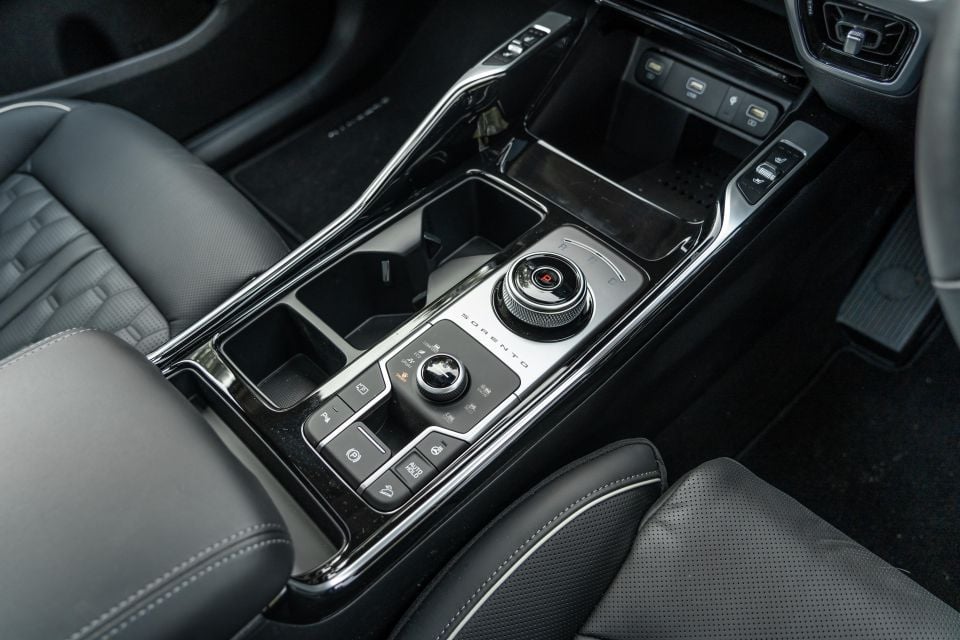
Where expert car reviews meet expert car buying – CarExpert gives you trusted advice, personalised service and real savings on your next new car.
However, it claims to be more responsive and far more efficient than before, with fuel consumption officially rated at a miserly 6.1L/100km on the combined cycle, a 1.1L/100km improvement on the previous model. There’s a 67-litre fuel tank, for reference.
While overseas models offer idle stop/start to further reduce consumption and emissions in heavy traffic, Kia Australia elected not to offer local models with the technology, arguing: “the benefits to fuel economy and CO2 emissions are negligible vs cost – the fuel economy and CO2 improvements in the new model are substantial over the outgoing third-generation Sorento irrespective of Idle Stop and Go”.
As noted earlier, the diesel engine is mated to an eight-speed DCT, putting power to the ground via an on-demand all-wheel drive system that defaults to front-wheel drive in normal conditions and engages the rear axle when slip is detected. A locked four-wheel drive mode can also be selected.
Kia Australia doesn’t officially quote any performance benchmarks, but a quick scan of the UK consumer site shows a claimed 9.1-second dash to triple figures for the AWD diesel, 0.4 seconds behind the 1.6-litre petrol-electric hybrid with all-wheel drive.
In the coming months Kia will release a 200kW/332Nm 3.5-litre V6 with front-wheel drive for those who want a little more power and/or don’t like diesels, while eco-friendly hybrid and plug-in hybrid versions with 169kW and 195kW respectively will arrive in 2021.
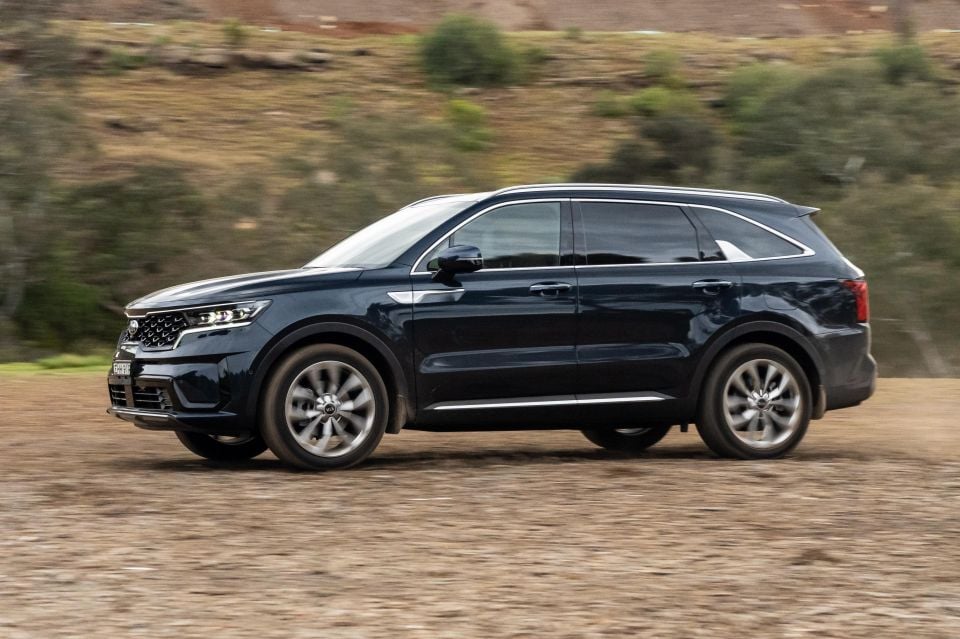
The last Sorento was praised as a refined drive, and the latest model builds on the strong points of its forebears.
Performance from the 2.2-litre diesel is decent across most situations, but as is the case for most oilers it does its best work on the highway. This latest model’s eight-speed DCT perhaps widens the gap between the Sorento’s low-speed and high-speed qualities, but it does an admirable job for what it’s worth.
Kia has done a good job at making the dual-clutch auto perform and feel like a really quick-shifting torque converter automatic, and for the most part there’s rarely any jitters that are commonly associated with this transmission type.
However, on occasion you’ll catch it out. Setting off from the lights, the Sorento can feel a little elastic or sling-shotty in first and then in the change up to second, something that is an issue with the older seven-speed dry-type DCT found in the likes of the Cerato GT and turbocharged versions of the Seltos.
This feeling can exacerbate the feeling of lag down low, too, and cause a jerky shove in your back as the diesel comes on boost and the clutch engages. Light, gradual throttle inputs are your best friend in normal driving.
Low-speed crawling and changing from drive to reverse (or vice versa) can also cause some hesitation in the transmission, too. The rotary shift-by-wire selector looks cool, but may also take some getting used to.
Once moving, and after the usually-awkward shift from first to second, the Sorento diesel is effortless and linear, and offers snappy gearshifts that are up there with the best from Europe.
Refinement is mostly good, with noise from the diesel engine and outside world generally well-suppressed across all conditions. The GT-Line’s big 20-inch wheels with 255/45 Continental tyres can be heard a little more than we’d like on coarse-chip surfaces.
The ride and handling is a good balance of comfort and engagement, erring on the side of comfort in a holistic sense despite the sporty GT-Line badging.
While Tony Crawford complained the GT-Line’s ride was too firm in town during his Australian launch drive, I personally found it to be pretty good. Sure, it’s on the firmer side, but the damping is at a level where road imperfections are noticed but not intrusive.
It’s certainly no worse than the standard setups you’ll find in most entry-level German products, notably those from BMW which are just too firm without adaptive damping.
That said, I agree the Sorento could benefit from an adaptive damping or air suspension setup, though the latter would likely prove too expensive. Having a slightly softer ‘Comfort’ mode would take the edge off successive bumps, where the Sorento can be a little ‘busy’.

The trade-off is that the Sorento is beautifully composed and refined on the open road, making this a fantastic highway cruiser. It’s this trait that my parents love so much about our MY13 Sorento, and it’s largely thanks to that local suspension tune.
Kia says it has ‘heavily revised’ the independent suspension system with geometry changes, new components and structural improvements compared to the old model, along with the 35mm increase in wheelbase to improve refinement. The new body shell also brings a 40 per cent improvement in tensile strength, to reduce body vibrations.
Australia is known for its choppy freeways and coarse-chip B-roads, and the Sorento soaks them up with gusto. It floats along quite nicely over larger undulations, with smaller lumps and bumps doing little to upset the Sorento’s overall vibe at speed.
The drivetrain happily hums away in eighth gear on the freeway, well under 2000rpm at 100km/h, and has plenty in reserve thanks to all 440Nm of torque being available from 1750-2750rpm. Overtakes are pretty effortless, and the diesel doesn’t get too raucous when pushed, either.
As for the steering and handling feel, the Sorento feels like a substantial car to pilot. There’s no getting away from the physics of it.
However, the tiller is nice and light but offers decent feedback so it doesn’t feel vague during tighter manoeuvres, and the body control when tackling corners is pretty composed given the Sorento weighs a smidgen over 1.9 tonnes (tare).
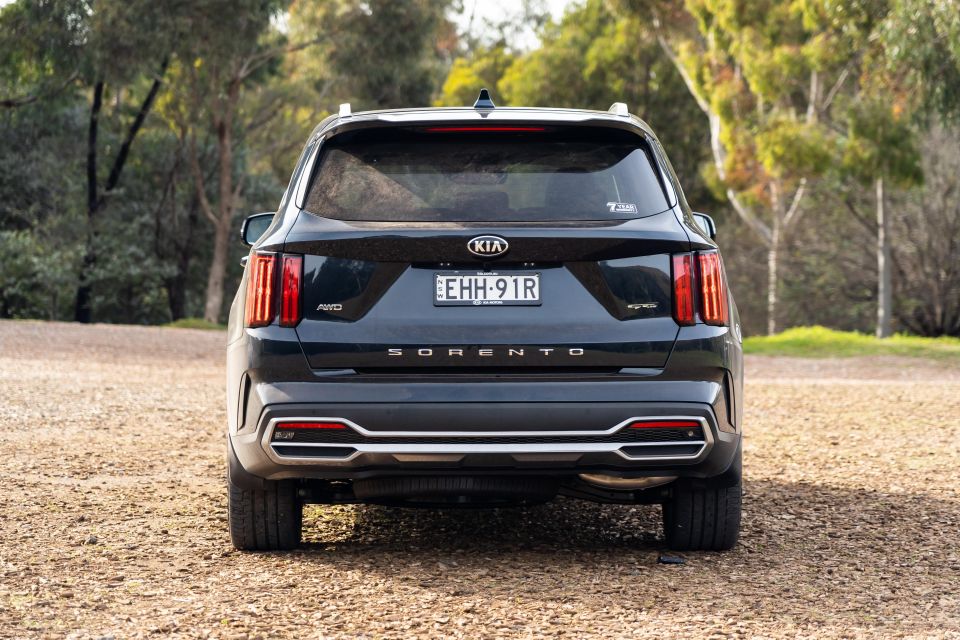
Kia is really pushing the Sorento’s active safety suite, and the GT-Line gets everything you can think of at this end of the market.
The adaptive cruise control and Lane Follow Assist systems combine to offer semi-autonomous highway driving capability, taking some of the stress out of the busy commute, for example. I really appreciated the Blind Spot View Monitor not just for showing when there was a vehicle in my blind spot but also looking at the kerb when I was parallel parking – can’t scratch those dark chrome 20-inch rims…
Unlike Honda’s LaneWatch system, Kia’s Blind Spot View Monitor shows live camera feeds on both sides of the vehicle, and projects the video into one of the digital dials in your instrument cluster rather than forcing you to glance at the central infotainment system. It also doesn’t cancel out the usual blind-spot assist system so you get visual and audible dings when there’s something in your blind spot.
The Sorento’s lane assist system is one of the best in the business, keeping you very much within the lines without being too intrusive or mis-reading markings like a lot of rival systems. Parking is much easier thanks to the crisp 360-degree camera system and surround sensors, though the Remote Smart Parking Assist feature is pretty gimmicky.
When the going gets a little tougher, the Sorento also offers selectable off-road terrain modes to tailor the drivetrain for loose surfaces – namely mud, snow and sand.
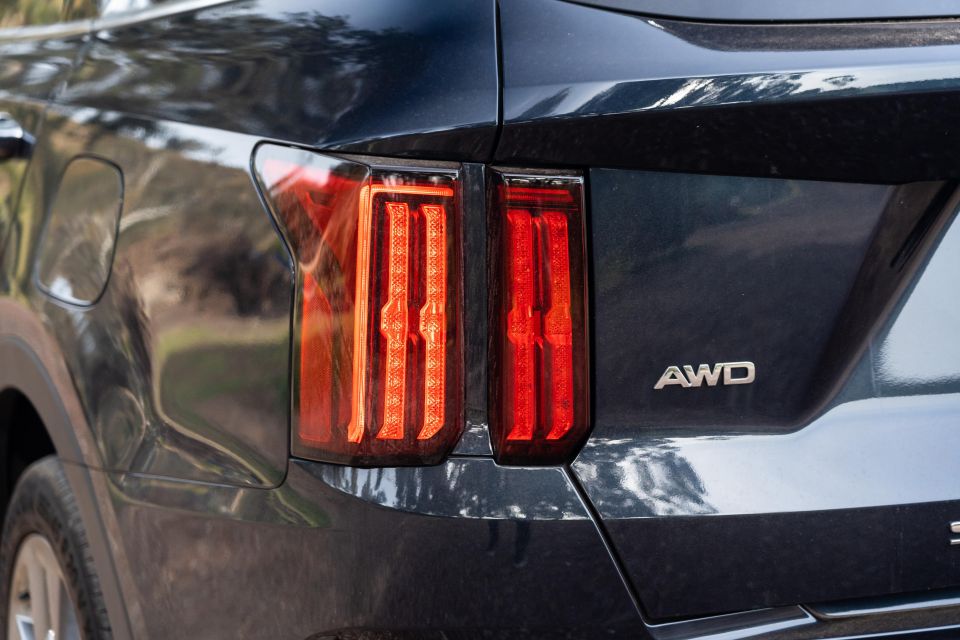
Like the wider Kia range, the new Sorento is covered by a seven-year, unlimited-kilometre warranty with capped-price servicing and roadside assistance covering the same time period.
The Korean brand’s title as warranty king may have just been taken, though, as Mitsubishi just announced a 10-year warranty and capped-price servicing program. Nonetheless, Kia remains one of the leaders in this area.
Scheduled maintenance for both 2.2-litre diesel and 3.5-litre petrol models is required every 12 months or 15,000km – whichever comes first.

The first five visits will cost you $335, $544, $408, $729 and $377, totalling $2393 over 60 months or 75,000 kilometres. Certainly not the cheapest.
As for fuel consumption we struggled to get close to Kia’s 6.1L/100km combined claim, seeing an indicated 8.7L/100km during our week with the car, skewed towards urban environments.
That real-world figure indicates a range of around 770km per tank in mixed driving, though longer stints on the freeway could easily see you achieve over 1000 kilometres between fills.
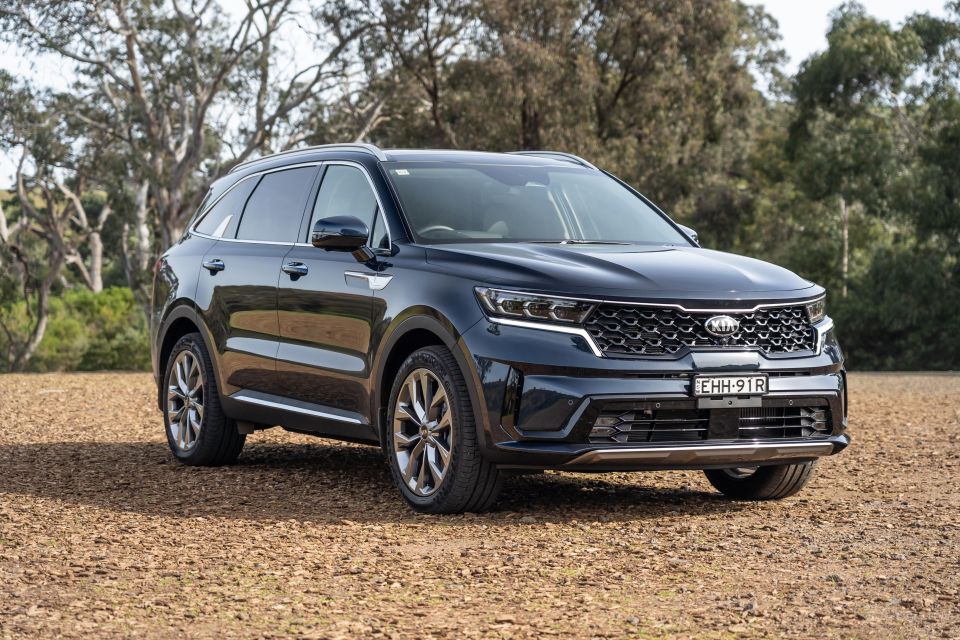
Does the new Kia Sorento GT-Line deliver on its promise of attainable luxury? Mostly.
In terms of features, technology and space (in the first and second rows), the Sorento can be considered a genuine alternative to large European SUVs while being tens of thousands dollars cheaper.
That said, there are still some areas for improvement. As it continues to grow in size, the Kia Sorento is begging for a more substantial powertrain.
Not to say the diesel is bad, but for a vehicle weighing nearly 2.0 tonnes with seating for up to seven, you’ll no doubt reach the 2.2-litre oiler’s limits with a full load of passengers and cargo. Since there’s a V6 petrol on the way, there’s no reason the Sorento can’t accommodate a six-cylinder diesel under the bonnet, which is still a staple for premium European SUVs.
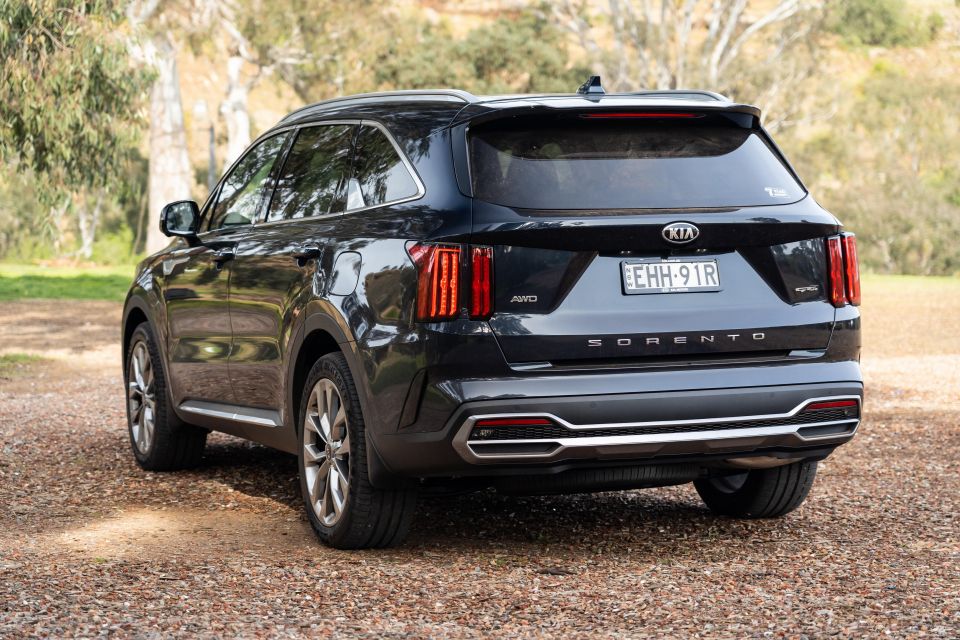
We’d also like to see more plush materials used throughout the cabin, curtain airbag coverage to the third row, and some further refinement to the drivetrain to further reduce NVH in diesel guise, and smooth out the DCT automatic’s behaviour on launch and when shifting from 1st to 2nd gear.
I’m really looking forward to the new hybrid models, which if priced right could see the Sorento become a mainstay on the sales podium for the large SUV class. Ditto the related Santa Fe which promises an even plusher cabin.
For most people though, who are likely upgrading from mainstream nameplates or older Kia models – like my parents, for example – the new Sorento GT-Line is a fantastic choice in the large SUV segment and offers most of what the luxury marques do for $30,000-$40,000 less.
Where expert car reviews meet expert car buying – CarExpert gives you trusted advice, personalised service and real savings on your next new car.
James Wong is an automotive journalist and former PR consultant, recognised among Australia’s most prolific motoring writers.


Damion Smy
10 Hours Ago


Damion Smy
12 Hours Ago


Damion Smy
13 Hours Ago


Damion Smy
15 Hours Ago


Damion Smy
16 Hours Ago


Damion Smy
18 Hours Ago